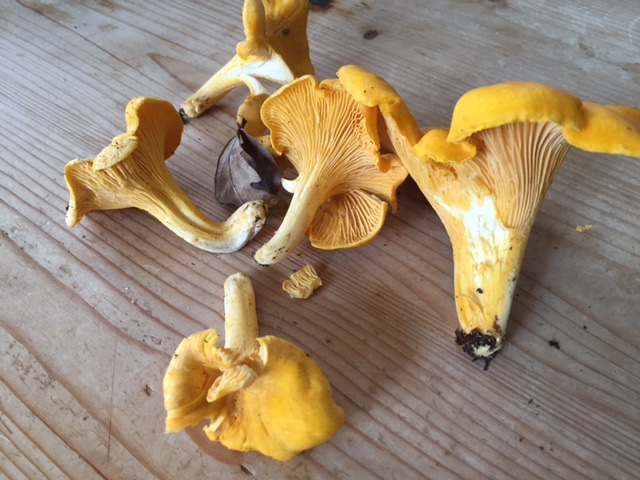
We read a lot these days about the benefits of connecting with nature and I’ve yet to find a better way of connecting with it than by finding, collecting and eating it. This very simple act really does change our relationship with wildlife in a way that’s hard to explain to those who haven’t yet tried it.
I thought I’d start with Chanterelles for several reasons. Firstly, it’s the right time of year to find them and, here in mid-Devon at least, the relentless wet weather means there is currently a bumper crop. Secondly, they are relatively easy to find (they almost seem to glow and can be spotted at a distance in even the gloomiest of woodlands) and they are difficult to confuse with anything unpalatable – though do, of course, check carefully using a reliable book or website. Try woodland with oak or beech trees and look along ditches or hedge-banks rather than wandering into the middle of a large expanse of forest.
Finally, and perhaps most importantly, they are one of the top two or three fungi species in terms of taste. On the continent, people have been known to come to blows over a profitable patch of Chanterelles though in my local countryside I have yet to encounter anyone else with the slightest interest in them or found any evidence that others are gathering them – which is great, or a bit depressing, depending on mood (and availability of Chanterelles).
They take about 6-7 minutes to turn into lunch and cooking them is as simple as adding butter, olive oil and garlic to a frying pan, cleaning away any obvious dirt or grit and lobbing them in – small ones whole, larger ones cut into pieces. Then just add to toast. If you don’t like the result then at least you will have found out something useful – foraging for wild fungi of any kind is probably not for you.
[registration_form]
I have my own wood where they grow under Birch and Bracken. I have taken some and moved to new areas to expand the growing of this amazing fungi. I have to watch what I am doing as the site is close to a public path and all though I love the public using the area I try not to encourage them off the path. This I do by placing nest boxes where they can see the birds and digging ponds for the kids to net for exotic creatures. Around the country like the New Forest there are areas where people are discouraged from picking wild mushrooms/fungi due to too much picking and a decline in species.
One suggestion if you want to learn more about fungi try joining your local Natural History group like mine in Carlisle [the oldest in the country!] They often have at least one fungi outing a year and are a great way to learn about them also visit new locations in your area you may not even know existed.
Good to hear that you are taking full advantage of Devon’s delights!
http://www.first-nature.com/fungi/hygrophoropsis-aurantiaca.php
(?)Apparently not to be confused with the False Chanterelle above?
Thanks Stella, yes it’s all good down here in the southwest and definitely a big change from the fens.
Murray, some care is needed with these things but if you look closely at the photos I don’t think they are too similar. Better safe than sorry though so leave well alone if in any doubt at all.
Ian Carter turning into a foodie!? I have seen everything now.